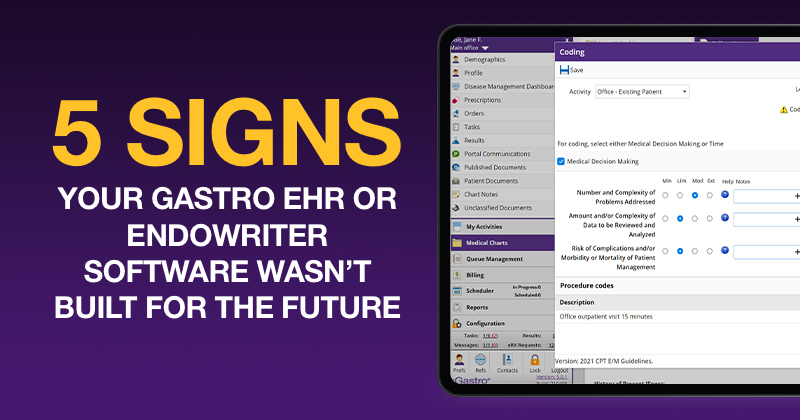5 Signs Your Gastroenterology EHR or Endowriter Software Wasn’t Built for the Future

Does Your Gastroenterology Software Have What It Takes or Is It Holding You Back?
Ever feel like your gastroenterology EHR or endowriter software isn’t built for the present day—much less the future? You certainly aren’t alone. However, there is some good news: every complaint you have about your current system is an opportunity for growth, IF you’re willing to make a change. Let’s talk about some of the most common issues we’ve heard from your peers— particularly those who became our clients.
Complaint #1: “My EHR was not built for GI.”
What happens when your software doesn’t understand your specialty? When the time comes to choose a diagnosis, it cannot be found. Or maybe, your EHR’s documentation flow doesn’t flow…and you’re forced to adjust the way YOU work to accommodate it. In other words, your EHR suffers from a general lack of intuitiveness—a symptom that’s all too common in many healthcare technology solutions on the market today, particularly those designed by technologists, without any input from actual doctors.
The solution: An EHR that’s GI-specific. One with built-in medical content right out of the box. One that understands your flow because it was built by people who know that flow, intimately. Medical content is programmed into the system by gastroenterologists, built-in suggested coding technology makes coding a visit easier and more efficient—and you can review how a bill was coded before you submit it. What does it all add up to? A system that simply understands you and how you work, helping you drive efficiency at your practice.
Complaint #2: “My staff spends hours reminding patients of upcoming appointments and procedures.”
Does it feel like your practice management software and patient engagement tools actually create more work for your team—not less? Is your front office staff still spending the majority of their day calling patients to remind them of important follow-ups or to confirm appointments that were already made?
The solution: Technology: particularly, hassle-free reminders. You worry that if your staff doesn’t follow-up your patient won’t show up, but what if you could use technology to help keep your patients on track? What if your staff could pull up a list of reminders for the day and send them all out with one click? What if you could customize certain reminders to go out automatically? What could happen? You just might save your staff lots of time so they move on to other important work.
Complaint #3: “My EHR and my endowriter aren’t mobile, but I am.”
Gastroenterologists are on the move— literally. They travel from room to room at their practices. Others spend time at ASCs, and still others travel back and forth between the hospital and their own practice, visiting with patients in each location. Gastroenterologists who are on-the-go should have an endowriter or EHR that’s just as mobile as they are. That way, you wouldn’t have to wait until you have access to your computer to see what’s next on your agenda or take care of simple tasks.
The solution: The solution: A mobile solution for your EHR and endowriter. One that goes with you, whether you’re visiting with patients in your practice or at the ASC, finishing up a few tasks from home, or doing your rounds at the hospital. Wouldn’t it be nice to renew a prescription right from your phone, get a quick view of your day’s schedule, or add a few quick notes to your patient’s chart on-the-go? Your EHR vendor should have an app for that.
Complaint #4: “We need to get our patients more engaged in their healthcare.”
Think about the technologies that power your everyday life: mobile apps, texts, notifications, online payments and scheduling. They are convenient, they help you complete important tasks quickly and they keep you connected to businesses you care about. So if your idea of patient engagement is a stack of papers, a phone, and a patient portal that has that 90s throwback look, it may be time to rethink your strategy.
The solution: Patient engagement tools. Reminders that come in the form of phone calls, emails or texts—however your patients prefer to communicate. Surveys that can be configured to go out automatically after a patient’s visit. Messaging capabilities that can open up the communication lines without tying up your phone lines. Convenient payment options tell the patient: “I know you’re responsible for a larger portion of your bill these days, and I want to make this easier for you.” After all, giving patients options or not is a choice— but it’s one that leaves a distinct impression, either way.
Complaint #5: “We aren’t sure where we really stand, financially.”
Whether you’re heavily involved in the billing and coding process or removed from it completely, it’s often worth some extra attention. After all, it’s the process that gets you paid. So, you’ll want to make sure you’re doing what you can to get reimbursed for services rendered, and that you’re keeping your finger on the pulse of your business—and ever-changing billing regulations.
The solution: Suggested coding and advanced analytics. Suggested coding works like this in gGastro®: your clinician adds a diagnosis, along with their notes, in the system. gGastro understands it and codes the visit on the back-end. You review the codes gGastro has chosen, make any changes and drop your bill. Simple. You can view the status of any claim in the clearinghouse interface within practice management (gPM™) and our advanced analytics can help you know where you stand financially. You can even run custom reports and get as granular as you need to, to help you make important business decisions.
So, the question remains, is your GI EHR or endowriter built for the future? If not, you may want to consider gGastro suite. gGastro is known for its GI-specific workflows and content—and now it’s designed to be faster and more modern than ever.




